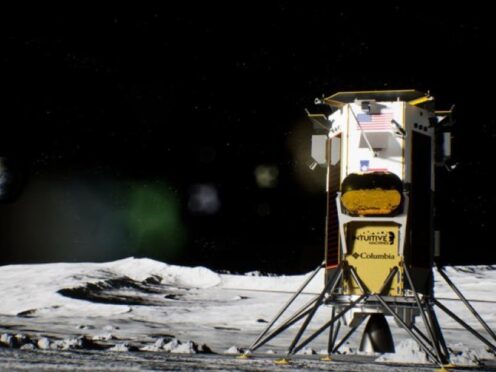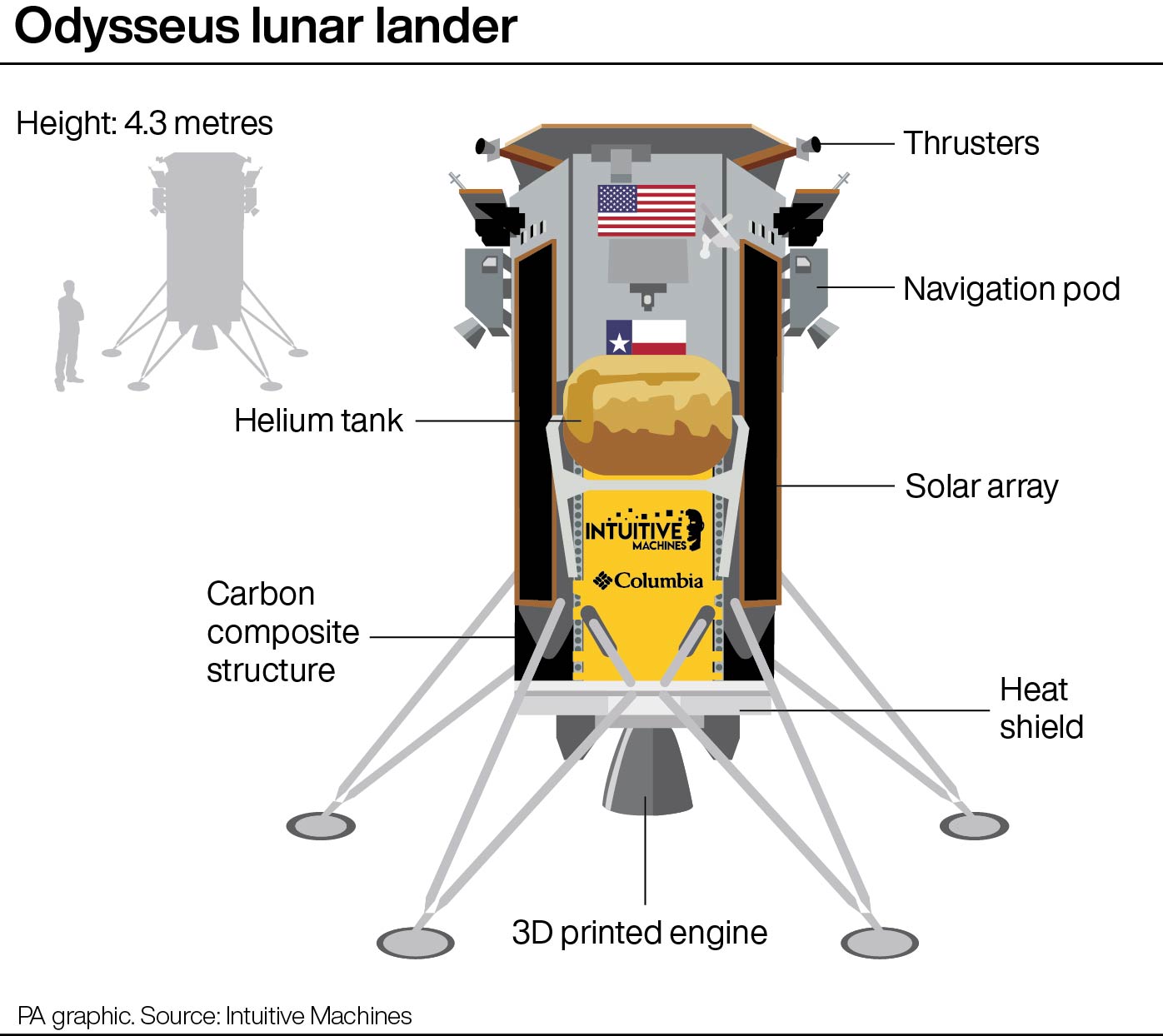
A lunar lander built by a US spaceflight company has become the first privately owned spacecraft to land on the Moon.
Intuitive Machines’s Nova-C Odysseus lander touched down on the Moon’s south pole region at 23.23pm UK time on Thursday.
The moment also marked the first US Moon landing since the final mission of the Apollo programme, Apollo 17, more than 50 years ago.
The news was confirmed by Intuitive Machine’s chief executive Steve Altemus, who said: “I know this was a nail biter but we are on the on the surface and we are transmitting.
“Welcome to the Moon.”
Your order was delivered… to the Moon! 📦@Int_Machines' uncrewed lunar lander landed at 6:23pm ET (2323 UTC), bringing NASA science to the Moon's surface. These instruments will prepare us for future human exploration of the Moon under #Artemis. pic.twitter.com/sS0poiWxrU
— NASA (@NASA) February 22, 2024
Shortly after landing, Intuitive Machines said on X, formerly known as Twitter, “flight controllers have confirmed Odysseus is upright and starting to send data,” after troubleshooting communications due to the weak signal from the Moon.
“Right now, we are working to downlink the first images from the lunar surface,” Intuitive Machines added.
The spacecraft blasted off last week from Cape Canaveral in Florida on top of a Falcon 9 rocket made by Elon Musk’s company SpaceX.
After troubleshooting communications, flight controllers have confirmed Odysseus is upright and starting to send data. Right now, we are working to downlink the first images from the lunar surface.
— Intuitive Machines (@Int_Machines) February 23, 2024
It embarked on a week-long journey, travelling more than 620,000 miles.
Nasa administrator Bill Nelson described the mission as a “triumph” and a “giant leap forward for all of humanity”.
He said: “Today, for the first time in more than a half-century, the US has returned to the Moon.
“Today, for the first time in the history of humanity, a commercial company – an American company – launched and led the voyage up there.
“And today is a day that shows the power and promise on Nasa’s commercial partnerships.
“Congratulations to everyone involved in this great and daring quest at Intuitive Machines, SpaceX, and right here at Nasa.
“What a triumph – Odysseus has taken the Moon.

“This feat is a giant leap forward for all of humanity. Stay tuned.”
But it wasn’t all plain sailing.
Intuitive Machines said the original laser instrument it planned to rely on for guidance during descent stopped working an hour before landing.
It meant the spacecraft had to do an extra orbit so engineers could activate a back-up instrument provided by Nasa.

The team is now working to gather more information on the lander to confirm its status and whether it can achieve its £93m mission.
Odysseus is a hexagonal cylinder about 13ft (4m) tall and 5ft (1.57m) wide – about the size of a British phone box – and weighs 1,488lb (675kg).
It is part of Nasa’s Commercial Lunar Payload Services initiative, which aims to involve commercial companies in the exploration of the Moon.
The spacecraft landed on Malapert A, a crater 186 miles from the Moon’s south pole.

The pole is thought to contain water ice, which would be a valuable resource for future human exploration.
Odysseus is expected to operate for roughly a week before the lunar night sets on the south pole.
On board are 12 payloads, including a Nasa instrument known as Scalpss (Stereo Cameras for Lunar Plume-Surface Studies), a four-camera system which aims to capture Odysseus’s descent to the lunar surface.
The lander is carrying a set of 125 tiny sculptures called Moon Phases, created by US artist Jeff Koons.
We’ve landed! Congratulations to Intuitive Machines & SpaceX for their astounding achievement of realizing this historic private mission to the Moon! I'm so honored to have my Moon Phases artworks be part of the Odysseus mission! @Int_Machines @SpaceX @NASA #jeffkoons #moonphase pic.twitter.com/yQq80zgdck
— Jeff Koons (@JeffKoons) February 23, 2024
It is insulated with a lightweight fabric, a shimmery gold material that normally lines the inside of ski jackets, made by US company Columbia Sportswear.
It comes six weeks after another US spacecraft, Peregrine, failed to touch down after a fuel leak.
Until now, controlled Moon landings have only been performed by government agencies, including the US, Soviet Union, China, India and Japan.
A second Intuitive Machines mission is slated to lift off next month, with the aim to drill for resources at the Moon’s south pole.

Enjoy the convenience of having The Sunday Post delivered as a digital ePaper straight to your smartphone, tablet or computer.
Subscribe for only £5.49 a month and enjoy all the benefits of the printed paper as a digital replica.
Subscribe